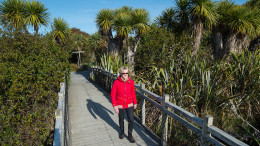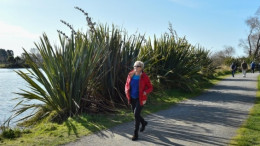Access
Styx Mill Reserve is near Northwood and has entrances off both Styx Mill Road and Husseys Road.
There is plenty of car parking at both entrances.
Metro info(external link) has up-to-date bus information.
Gates and opening hours
- Daylight savings 7am to 9pm
- Rest of the year 7am to 7pm
- Ring Christchurch City Council on 0800 800 169 or 941 8999 to release locked in vehicles, at owner's expense.
Dogs
Dogs are prohibited, to protect wildlife, except for the following places, where dogs are allowed with the following rules:
- leashed on the path that runs from the Styx Mill Road car park, along the back of the Styx Mill Transfer Station, to Styx Mill Road
- leashed on the Styx Mill Perimeter Walk that runs around the outside of the predator-proof fence in the reserve
- effective control in the open field area
- off-leash and under effective control in the fenced dog park.
Bikes
Bikes are prohibited from Styx Mill Reserve.
Toilets
Public toilets are available near the Husseys Road car park.
Mahinga kai
The extensive wetlands and easy access to the sea made the Styx an important area for mahinga kai (food gathering) and for the cultivation and harvesting of flax, kiekie, raupō by local Māori.
Wetlands were often divided into sections that would be carefully tended to by a hapu/clan or whanau/family. Food gatherers would then distribute to the community which would result in strong relationships between families.
Food collected in the area included koreke/quail, duck, eel and pānako (a species of fern) as well as the cultivation of turnips and potato. The Pūharakekenui river provided tuna/eels, kanakana/lamprey and waikōura/freshwater crayfish.
Styx Mill
In order to safely cross the Pūharakekenui/Styx River, sticks were laid out to mark safe passage on firm ground. It is possible this is how the river received its English name, the spelling change to reflect the mythical Greek river 'Styx' occurring during the 1860s.
During European settlement, the area was used for a number of purposes including sheep farming and milling. The river was used to drive waterwheels and provided an important source of power for sawmills and flaxmills. While not much is known about the mill at Styx Mill or what it produced, it changed to be a flour mill in 1861 because the land was so good for growing wheat.
By the time the First World War came along, milling had ceased on the site.
Reserve and community
The Styx Mill Conservation Reserve area came into public ownership in the 1970s with development beginning in the 1980s. Community involvement began with the 'Styx River Happening' at Spencer Park in March 1999 and resulted in the formation of the Guardians of the Styx Charitable Trust. A sub-group, the Styx History Group researches the history of the river and its surrounding area, with a primary focus from 1850.
The low-lying wetland reserve is of high ecological value and retains a significant amount of native vegetation that is locally uncommon. The Pūharakekenui/Styx River has a number of native species that pass through the catchment and out to sea.
Research suggests that during the 1850s, about 39 different species of birds would have resided in the wetland but European settlement displaced 19 of these over time. Recently, with an improving habitat and wider displacement of birds due to urbanisation, a number of species have returned to the reserve.
Historically, the Styx Mill basin was also a natural flood retention area due to the surrounding river terraces and groundwater that is close to the surface. This function continues today.
Get involved in your local or favourite park.
Keep an eye on our volunteering page for special events.





